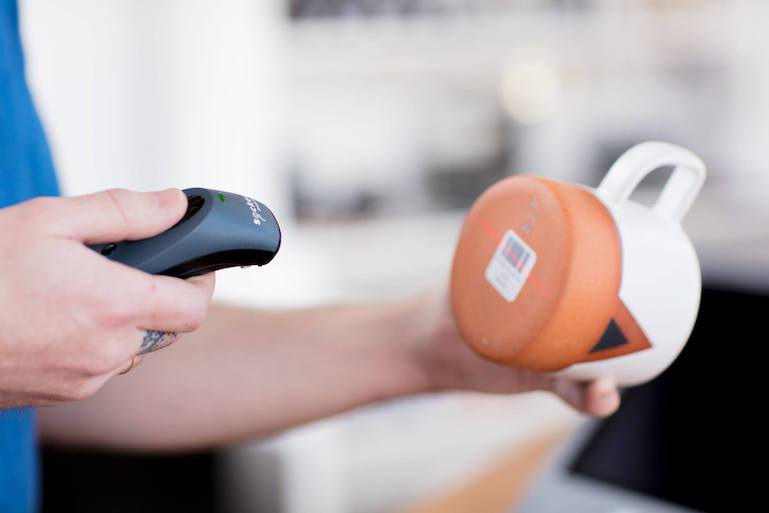
How to Take Inventory For a Small Business: 9 Tips to Kickstart Your Strategy
There are few things more critical to the success of your small business than a robust and well-rounded inventory management process. The trouble is, if you’ve never had to manage inventory before, it’s tough to know where to start.
With inventory management, there can be dozens of moving pieces. It’s made even more complicated by the fact that there’s no one right way to manage inventory. What works for the business down the street may not work for yours.
If your head’s already spinning, don’t worry. We’re here for you. In this article, we’ll help you understand inventory management, give you a set of universal guidelines that you can tweak, and generally show you how to take inventory for a small business.
First, What is Inventory Management?
Simply put, inventory management is a process and set of systems for managing inventory and stock. It’s a subset of the much broader supply chain management concept. For most retail or food service businesses, inventory management is going to encapsulate the following tasks:
- Ordering stock
- Storing stock
- Selling stock
- Tracking stock levels
While these tasks may seem mundane, and even “simple” or “easy,” doing them and doing them well helps create a rock-solid foundation for your business to operate from. What does that mean exactly? You will avoid potential problems and enjoy optimizations like:
- Prevent out of stock issues for your popular products
- Know the kinds of sales/promos to run to move underperforming stock
- Know the right quantity of items to keep on hand to maintain optimal cash flow
- If you sell perishable goods, it can help you avoid spoilage
Now that you understand what inventory management is and how it can help your business, let’s take a look at some of the general principles that should guide your inventory management strategy.
Maintain a High Level of Organization
The first step in staying on top of your inventory is to organize your items with as much data and product information as is reasonably possible. Successful inventory management is a direct result of rock-solid data analysis. By starting with rich, accurate product data, you’ll avoid errors down the line and have an easier time investigating any issues you might uncover. Typically this data entered into a point of sale (POS) system, but if you run a small business with less than 100 products, and also use an electronic cash register, it may be possible (but very tedious) to track this data with spreadsheets. Seriously, using a POS for this will save you a ton of time.
That being said, here’s some of the data you’ll want to input for each product:
- Name
- Department
- Category
- SKU
- UPC
- Supplier and Supplier ID
- Sales Price
- Tax Rate
- Discountable (Y/N)
- Cost per Item
- Current Quantity
- Reorder Trigger
- Recommended Order
If you sell items with variants, you’ll want to make sure that you enter each variant as part of your data input process. If you’re unfamiliar with the term, the classic example of an item with variants is a t-shirt that’s sold in multiple sizes and colors. Each combination of size and color is a unique variant of one parent product. By creating variants, you will be able to track the quantity, sales data, and more for each variant on an individual basis.
Receive Inventory Accurately
Much like our first tip, you’ll want to ensure that you receive and input new stock from suppliers into your point of sale system as accurately as possible. Entering the wrong product quantity or mislabeling a product can cause a bunch of issues later that can all be avoided. The best way to ensure that you receive an input stock from suppliers accurately is to create a standardized process and follow it every time you receive a shipment.
Here’s an example of what that process might look like:
- Whoever is receiving the shipment should have a list of the items you’ve ordered or a copy of the original purchase order.
- The receiver should ensure that all expected boxes/packages are received (i.e., nothing is left in the truck).
- The receiver should unpack all boxes and compare the contents against the list or purchase order.
- If there are no errors or issues, go ahead and enter the shipment data into your POS, spreadsheet, or other tracking systems.
- If there are issues, take note of them and contact your supplier. You can then enter the rest of the shipment into your system.
Because receiving an order accurately is such an important part of inventory management, you may want to handle this part of the business yourself, or rely on a trusted senior employee.
Use the Right Tools
As we’ve hinted at throughout the article, inventory management is a lot simpler when you use a point of sale system. This is the case because of the quantity of data and the rate at which inventory turns over within most retail and food service businesses. If you try to manage it all with a spreadsheet, or worse, pencil and paper, it’s highly likely that the task will start to feel like a burden that you want to skip at the end of a busy day. Plus, with so many moving parts, you increase the likelihood of errors, which can throw off all of your inventory data.
With a POS system, outside of creating your product catalog (typically done once per product) and receiving new stock, inventory management is an automated process. When you sell a product, your stock levels are automatically updated. You can easily query your system to see how much you have of a product on-hand, and there are typically detailed inventory reports that you can use to better understand what’s going on in your business.
Make Data-Driven Decisions
One of the main reasons to use a POS, especially from an inventory management perspective, is the variety of reports you’ll have at your disposal. These reports will cover everything from sales volume by product, profit margin analysis, inventory turnover rate, and much more. With this information, you’ll be able to make more informed decisions that help you shape your overall business strategy. Here are a few of the insights that you can expect to derive from your point of sale system’s reporting capabilities:
- Identify your top selling items so you can prioritize keeping them well stocked
- Monitor profit margins per product so that you can identify opportunities to renegotiate with your suppliers
- Check your inventory value at any given time to understand how much capital you have tied up in inventory
If you’re an Excel wizard who has a deep understanding of business analytics and supply chain management, It’s certainly possible to create similar reports with spreadsheet software and custom formulas. However, you’ll have a much easier time of it if you get a POS system and let it do the number crunching for you. Plus, this frees you up to focus on tasks that have a higher strategic value like interpreting your reports and make decisions based on them.
Have a Formal Process in Place
While tools like a POS or dedicated inventory management software can help to simplify inventory management and allow you to get more value from your data, you still need an overarching process in place. The two most popular methods are First In, First Out (FIFO) and Last In, First Out (LIFO).
Businesses that use FIFO essentially make an effort to sell older stock before newer stock. For certain business types, like those that sell perishable goods, FIFO is a necessary means of deriving as much value from stock as possible. For example, imagine how a convenience store stocks drinks. Items in the front of their refrigerators typically expire sooner than objects placed in the back.
LIFO, on the other hand, prioritizes selling the newest items first. Companies typically use LIFO when the price of stock fluctuates frequently. If the cost of stock increases, a company’s margin will decrease. On the surface, this might seem like a bad thing, but it also results in lower revenue and less of a tax burden. It’s this lower tax burden that attracts some businesses to the LIFO method.
Regardless of the overarching system you use, it’s essential that you understand the pros and cons of each approach so that you can select the right one for your business.

Do Regular Inventory Counts
Even if you have a POS system or inventory management tool in place, as well as a rock solid process for receiving stock, you’ll still want to do manual inventory counts periodically. Depending on the size of your business, you might do these on a semi-annually, quarterly, or even monthly basis.
These counts are important because they function as a backup to your day-to-day system, and can help you uncover flaws in your process, or more significant issues like employee theft. If the idea of setting aside the time to count all of your inventory at once sounds a little overwhelming, don’t worry, you can also perform cycle counts.
Cycle counts are quicker checks where you count only a smaller portion of your inventory. For example, one month you might check your shoe inventory, and another your hat inventory. Besides saving you time, doing so can help you uncover issues much more quickly than a more massive quarterly check, though experts recommend that you do at least one full inventory count per year for income tax reporting.
SEE ALSO: Getting Started with Simple Inventory Control Procedures
Set Up Reorder Triggers
One of the more difficult aspects of inventory management is staying on top of your quantity on-hand, so you know when you need to reorder more stock. A great way to solve this challenge is through the use of reorder triggers. A common feature in most POS systems, reorder triggers allow you to specify the stock level that will trigger an alert for you to re[purchase a particular item.
You can even pair these reorder triggers with a recommended reorder amount that makes the reordering process even easier. This ensures that you don’t irritate a customer, or lose out on sales because you’re out of a popular product. Similarly, you won’t tie up too much money in an excessively large order.
Track Raw Goods
Much of the inventory management advice out there focuses on traditional retail businesses with shelves stocked with goods or racks filled with clothing. What about inventory management for food service businesses? While covering all the ins and outs would require its own article, we’ll leave you with one piece of advice. Track your raw goods. What does this mean exactly?
Tracking raw goods allows you to manage all of the components of a larger item. For a coffee shop that could mean monitoring coffee beans, milk, and sweetener quantities. While the quantity of each that’s used in a recipe will vary based on the size of the drink, having all of this programmed into your POS system will help you ensure that your team is using the right portion control techniques. It will also help you get the appropriate amount of revenue from your inventory and not lose money.
Watch out for Inventory Shrinkage
One of the biggest threats to your bottom line is inventory shrinkage, so it’s something you’ll want to watch out for. If you’re unfamiliar with the term, inventory shrinkage is one of the primary contributors to inventory loss. The causes of loss can be shoplifting, employee theft, supplier error, damage, etc. and it’s a huge problem for retailers. In fact, according to the Nation Retail Federation (NRF), retail shrinkage caused a $46.8 billion loss of money for U.S. retailers in 2017.
While there’s no one-size-fits-all approach to preventing inventory shrinkage, using the tools and tactics we’ve shared throughout this article is the best way to start. Should you identify an inventory shrinkage problem, you’ll want to consider these prevention techniques and internal controls:
- Hiring in-store security staff that can monitor customer behavior
- Installing security cameras and other monitoring devices like security tags for clothing
- Ensuring a trusted manager is always present when stock is received
- Conducting frequent and rigorous inventory counts
There you have it, a set of tools and principles you can use to take inventory for your small business, regardless of your industry. As with anything in business, test out a few of the ideas in this article first, and monitor how they impact your business. Once you’ve found a few that work for you, consider building out a more robust inventory management strategy to drive real results for your business’ bottom line.
Want to try ShopKeep for yourself?
Just answer a few easy questions.
Need help finding the right point of sale?
Just complete the form. We’ll call you right back to explain how ShopKeep can work for you.
Hit the ground running.Sprinting, in fact!
Read our free, comprehensive guide, Small Business 101, to learn all you need to know about starting a thriving business.

